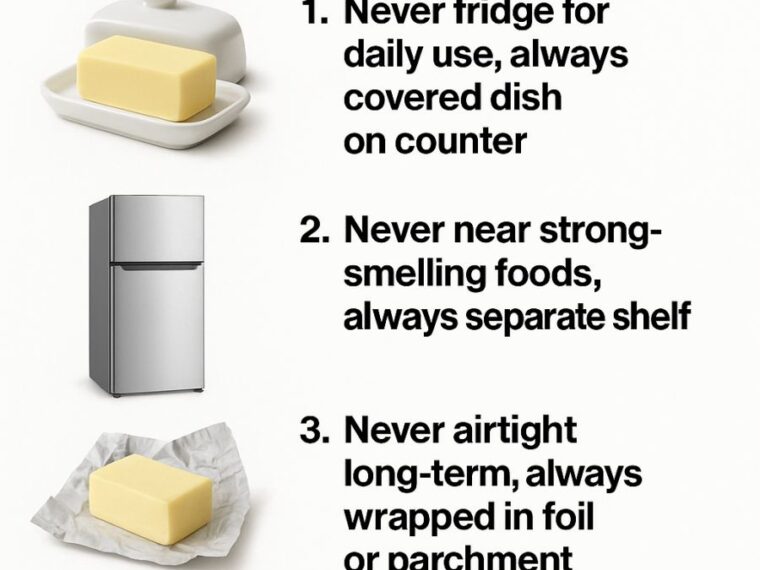Butter is a staple in many households, yet the way we store it often leads to a compromise in its flavor and texture. A common sight is butter wrapped in its original packaging, tucked away in the corner of a refrigerator door or left out on a counter, exposed to air and odors. These practices not only affect the taste of the butter but can also lead to spoilage far sooner than necessary.
Understanding the correct methods for storing butter can significantly extend its shelf life and preserve its rich, creamy texture. Whether you’re a casual baker or someone who enjoys butter on toast every morning, knowing how to store your butter properly can enhance your culinary experiences and keep your butter fresh for longer.
1. The Importance of Proper Butter Storage
Proper butter storage is crucial to maintain its quality and taste. Butter is made up of fat, water, and milk solids, which can be affected by exposure to air, light, and strong odors. When left uncovered, butter can quickly absorb flavors from surrounding foods, leading to an unpleasant taste. Furthermore, exposure to air can result in oxidation, causing the butter to become rancid. Ideally, butter should be stored in a cool, dark place to prevent these issues.
Temperature is another important factor in butter storage. Butter should be kept at a consistent temperature to prevent it from melting and refreezing, which can alter its texture. The ideal storage temperature for butter is between 32°F to 35°F (0°C to 1.6°C) in the refrigerator. However, for immediate use, keeping butter at room temperature is acceptable, provided it is consumed within a few days.
2. Keeping Butter Out of the Fridge for Daily Use
For those who use butter regularly, storing it outside the fridge can be convenient and improve its spreadability. When kept at room temperature, butter remains soft and easy to spread, which is ideal for applications like bread or toast. However, to prevent spoilage, it is recommended to keep only a small amount of butter out at a time, typically enough for one or two days of use.
Using a butter dish with a cover is essential when storing butter at room temperature. This protects the butter from air and contaminants, maintaining its freshness. It’s important to place the butter dish away from direct sunlight and heat sources, which can cause the butter to melt and spoil.
3. Why You Should Use a Covered Dish on the Counter
Using a covered dish for storing butter on the counter is one of the best ways to protect it from air, light, and odors. A covered dish acts as a barrier against contaminants and helps maintain the butter’s flavor. There are various types of butter dishes available, including ceramic, glass, and stainless steel, each offering different levels of protection.
A butter bell, or French butter dish, is a popular option that uses water to create an airtight seal, keeping the butter fresh without refrigeration. This method not only preserves the butter’s taste and texture but also enhances its aesthetic appeal on your kitchen counter.
4. Avoid Storing Butter Near Strong-Smelling Foods
Butter has a tendency to absorb strong odors from its surroundings, which can alter its taste. To prevent this, it’s important to store butter away from foods with strong smells, such as onions, garlic, and certain cheeses. In the refrigerator, this means keeping butter on a separate shelf or using a butter compartment that offers some protection from other food items.
If you’re storing butter at room temperature, ensure that it is in a covered dish and positioned away from other aromatic foods. This will help maintain its pure taste and prevent it from developing off-flavors that can detract from its natural creaminess.
5. The Benefits of a Separate Shelf for Butter
Designating a separate shelf for butter in your refrigerator can help maintain its freshness and prevent cross-contamination. By keeping butter isolated, you minimize its exposure to strong odors and flavors from other foods. This dedicated space should be at the back of the fridge, where temperatures are more stable, reducing the risk of temperature fluctuations that can affect the butter’s consistency.
In addition to protecting the butter from undesirable aromas, a separate shelf allows for better organization within the refrigerator, making it easy to locate and access your butter whenever needed. This practice ensures that the butter remains at its best quality for a longer period.
6. The Downside of Airtight Containers for Long-Term Storage
While airtight containers are excellent for preserving the freshness of many foods, they are not always the best choice for long-term butter storage. When butter is sealed in an airtight environment, it can trap moisture, leading to changes in texture and potentially causing the butter to become rancid faster.
For long-term storage, it’s better to wrap butter in foil or parchment paper, which allows it to breathe slightly while still providing a barrier against odors and light. If you must store butter for extended periods, consider freezing it instead, as this method preserves its quality without the risk of moisture buildup.
7. Wrapping Butter in Foil or Parchment for Longevity
Wrapping butter in foil or parchment paper is one of the most effective methods for preserving its quality over time. These materials provide a protective barrier against light and odors, which can degrade the butter’s flavor and texture. Foil, in particular, offers an excellent shield against light, making it ideal for long-term storage.
When wrapping butter, ensure that it is tightly sealed to prevent air exposure. This method is especially useful for storing butter in the refrigerator or freezer, as it prevents the butter from absorbing unwanted flavors or becoming affected by freezer burn.
8. The Pitfalls of Freezing Salted and Unsalted Butter Together
Freezing butter is a great way to extend its shelf life, but it’s important to store salted and unsalted butter separately. Salted butter can impart its flavor to unsalted butter if they are stored together, affecting the taste of your recipes that require a more neutral butter flavor.
To avoid this, wrap each type of butter in separate foil or parchment paper, and label them clearly before placing them in the freezer. This practice ensures that your butter maintains its intended flavor profile and is ready to use for specific culinary purposes when needed.
9. How to Properly Separate and Store Different Types of Butter
Different types of butter, such as salted, unsalted, and specialty butters (like cultured or flavored varieties), should be stored separately to preserve their unique characteristics. This is particularly important if you use butter for various culinary applications that require specific flavors and textures.
To properly store these butters, wrap each type individually in foil or parchment paper, and label them clearly. This prevents cross-contamination of flavors and ensures that each butter retains its intended taste. Additionally, storing them on different shelves or compartments in your refrigerator can further prevent flavor mixing.
10. Viral Butter Storage Hacks: What Works and What Doesn’t
The internet is rife with butter storage hacks, but not all of them are effective or safe. One popular hack involves using a butter keeper or bell, which, as mentioned earlier, can be effective for short-term storage at room temperature. However, some hacks, such as leaving butter out in a dish uncovered, can lead to spoilage and contamination.
Another trending hack is freezing butter in small portions, which can work well for long-term storage, allowing you to thaw only what you need. However, it’s crucial to wrap the portions properly to prevent freezer burn and flavor transfer. Always evaluate the practicality and safety of viral hacks before trying them out in your kitchen.
11. The Science Behind Butter Freshness and Temperature Control
Butter’s freshness is heavily influenced by its exposure to air, light, and temperature. The fats in butter can oxidize when exposed to air, leading to rancidity. Light exposure can cause butter to develop off-flavors, while temperature fluctuations can alter its texture and consistency
By understanding the science behind these factors, you can make informed decisions about how to store your butter. Keeping butter at a consistent temperature, using protective wrappings, and storing it away from strong odors are all practices rooted in maintaining its freshness. These methods ensure that your butter remains flavorful and easy to use, whether you’re spreading it on toast or incorporating it into your favorite recipes.





